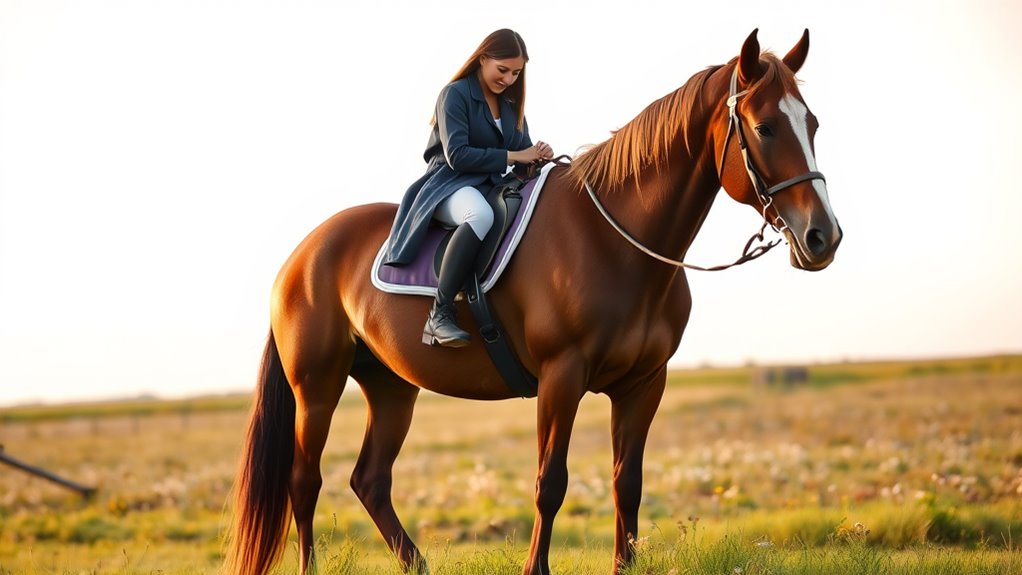After childbirth, you should return to riding gradually, prioritizing your body’s healing process. Start with brief, low-impact rides and focus on gentle, controlled movements. Be patient, listen carefully to signals from your body, and incorporate pelvic floor exercises to rebuild core strength. As your confidence and strength grow, slowly increase ride duration and intensity. Supporting routines and equipment can also help. Want to discover more tips for a safe, smooth comeback? Keep exploring.
Key Takeaways
- Start with short, low-impact rides focusing on gentle movements and proper warm-up and cool-down routines.
- Prioritize pelvic floor exercises to rebuild core strength and improve stability before increasing riding duration.
- Listen to your body closely, taking regular breaks and avoiding overexertion to prevent setbacks.
- Gradually increase ride length and intensity only as your strength, confidence, and comfort improve.
- Use supportive riding gear and seek guidance from healthcare providers for personalized recovery progress.

Returning to riding after having a baby can be both exciting and challenging, but it’s important to approach the process carefully. Your body has undergone significant changes, and giving yourself time to heal is essential. Many new mothers face breastfeeding challenges, which can impact your energy levels and posture. If you’re breastfeeding, focus on maintaining good nutrition and staying hydrated, as these will support your recovery and riding goals. Be mindful of how breastfeeding affects your body—sometimes, you might experience soreness or fatigue, which can influence your riding ability. Taking regular breaks and listening to your body’s signals will help prevent overexertion.
Returning to riding postpartum requires patience, listening to your body, and caring for your recovery and energy levels.
A key part of your postpartum recovery is strengthening your pelvic floor. Pelvic floor exercises, often called Kegels, are indispensable for rebuilding strength and stability in this area. These exercises can help alleviate common postpartum issues like incontinence and pelvic discomfort, and they also support your core, which is essential for riding. Incorporate pelvic floor exercises into your daily routine gradually. Start with gentle contractions, holding each for a few seconds, then release. Over time, increase the duration and repetitions as your muscles regain strength. Consistency is more important than intensity at this stage. As your pelvic floor improves, you’ll notice better control and a more comfortable riding experience.
When you’re ready to get back in the saddle, start with short, low-impact rides. Avoid pushing yourself too hard too soon. Focus on gentle, controlled movements and pay close attention to how your body feels during and after riding. It’s normal to experience some soreness initially, but persistent pain is a sign to slow down. Proper warm-up and cool-down routines will help prevent injury and aid recovery. Don’t forget to wear supportive riding gear, including a well-fitted helmet and appropriate riding attire, to keep yourself comfortable and safe.
As your confidence and strength build, gradually increase the duration and intensity of your rides. Keep communication open with your healthcare provider or a postpartum fitness specialist if you experience any issues or concerns. Remember, every mother’s recovery timeline is unique, so be patient and kind to yourself. Celebrate small milestones along the way—each step forward is a sign that you’re returning to riding safely and gradually. Additionally, choosing appropriate equipment can help support your body during recovery and reduce discomfort. With patience, proper care, and attention to your body’s needs, you’ll find your rhythm again and enjoy riding postpartum.
Frequently Asked Questions
When Can I Start Riding After a C-Section?
You should generally wait at least 6 to 8 weeks after a C-section before riding again, but listen to your body and consult your healthcare provider. Focus on gentle abdominal exercises to rebuild core strength and improve pelvic stability first. Avoid strenuous activity until you feel confident and pain-free. Gradually reintroduce riding, starting with light sessions, ensuring your body feels ready for the physical demands of riding again.
How Do I Rebuild Core Strength Safely?
To rebuild core strength safely, focus on pelvic stability and abdominal rehab exercises. Start with gentle, targeted movements like pelvic tilts and deep breathing to activate your core muscles. Avoid strenuous activities until your healthcare provider approves. Consistently practice these exercises to regain strength gradually, ensuring proper form. This approach helps protect your healing process, enhances stability, and prepares you for more advanced riding activities as you regain confidence and strength postpartum.
Are There Specific Exercises to Prevent Pelvic Injuries?
To prevent pelvic injuries, focus on pelvic floor exercises like Kegels, which strengthen the muscles supporting your pelvis. Incorporate gentle stretches and core stability exercises to improve overall pelvic health. Always listen to your body and progress gradually. Consistent practice helps prevent injuries, enhances stability, and supports your riding. Remember, injury prevention starts with strengthening and maintaining your pelvic floor muscles for safe, confident riding postpartum.
How Do I Manage Fatigue While Returning to Riding?
To manage fatigue while returning to riding, focus on energy management by pacing yourself and incorporating short, manageable sessions. Use riding accessories like supportive saddle pads and proper gear to reduce strain and conserve energy. Listen to your body, take regular breaks, and stay hydrated. Prioritize quality over quantity, gradually increasing your riding time to build stamina safely, ensuring you enjoy your ride without overexertion.
Can Riding Help With Postpartum Mental Health?
Riding can boost your postpartum mental health by reducing anxiety, enhancing mood, and fostering confidence. It offers physical benefits like improved posture and strength, alongside emotional benefits like relaxation. As you ride, you can experience the calming effects of connection with your horse, promoting mindfulness and reducing postpartum anxiety. Plus, the benefits of breastfeeding, like oxytocin release, complement riding’s positive impact, helping you feel more balanced and resilient in your postpartum journey.
Conclusion
So, after all your careful, gentle progress, you might find yourself back in the saddle—literally—only to realize that the real challenge was resisting the urge to rush. Irony strikes as you discover that patience and caution paved the smoothest path. You thought you’d reclaim your riding prowess quickly, but it’s the slow, thoughtful return that truly reignites your passion—and proves that sometimes, going slow is the fastest way forward.









